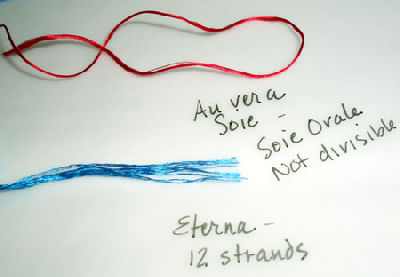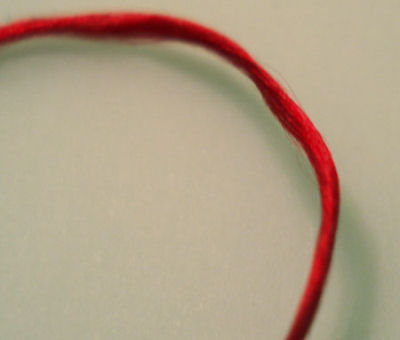Silk embroidery floss is perhaps one of the most pleasurable and beautiful threads to work with, and there are a variety available on the market. When I’m looking for “flat” silk, though, it isn’t as easy to come by. Even the shops that carry, for example, Soie Ovale only carry select colors, and you have to wait for a special order if you want something out of the ordinary. I’ve compared two flat silks here, with photos, so that you can “see before you buy.”
First of all, what is flat silk? Well, in my book it’s untwisted silk embroidery threads or “amost-untwisted” (with a very subtle twist). Your standard stranded embroidery floss, if you look at it closely, has a twist to it that holds the even smaller strands together. This stuff comes in cotton, silk, rayon, linen…. etc. But the untwisted silk lies flat (more or less), and, as far as threads go, has the highest “natural” sheen, which will last for years and years and years and years. That’s the nature of silk.
Compared to rayon floss (which is also shiny), the flat silk is somewhat easier to work with. The silk is also, in my opinion, “richer” – and the fact that it’s a natural fiber is also a big sell point for me.
So, in searching for flat or nearly flat silk over the years, the only two “standard” brands I’ve ever found are the Au Ver a Soie (Soie Ovale) and the Eterna Stranded silk, which has very little twist to it. Apparently, Kreinik also, once upon a time, sold a flat silk called Soie Platte, which was also the former name of Soie Ovale by Au Ver a Soie. On some websites, I’ve seen Kreinik Soie Platte listed, but it’s not on their official website. Now, I don’t know – I think there must’ve been some kind of cufuffle about four or five years ago, because I recall Kreinik’s label on the Soie d’Alger stuff in some shops back then. Perhaps it was a marketing glitch of some sort? Who knows!
So I’ve found only two readily available “flat” silks, and I thought I’d show you the difference between them with photos. Sometimes it’s just nice to see what you’re ordering….

First off, Soie Ovale is pretty much non-divisible, unless you want to go to a whole lot of careful trouble. The Eterna silk divides into 12 strands.

Up close, this is the end of the Soie Ovale.

And these are the ends on the Eterna. Notice there’s barely a hint of a twist.

This is the “body” of the Soie Ovale. It’s very smooth.

And this is the “body” of the Eterna. Note the twist – the strands twist together, but when they are separated, they are not individually as twisted.

Soie Ovale comes on a spool, with 15 meters per spool. There are 59 colors made, but I’ve only ever seen 54 available (some by special order) in American shops.

Eterna comes in a hank (not a pull skein – you have to take the sleeve off and snip off the knot and unwind the length you desire from the hank). There are 5 meters per hank, and it comes in 545 shades.
Basically, you get 3 times as much thread on the Au Ver a Soie spool, but I’ve found that 4 or 5 strands of Eterna, when worked with a laying tool, cover about the same space as one strand of Soie Ovale, so I think that the amount of coverage for the hank and the spool is pretty close to the same.
The price difference is kind of interesting: $2.50 – $3.35 for the Soie Ovale, depending on where you’re ordering it, while the Eterna runs $0.95 per little hank.
Which thread do I like better? The Soie Ovale is lovely – it’s so nice to work with and is such a rich, smooth silk. I like it best. BUT – for the price and for the color range, you can’t really beat the Eterna. I’m not an expert in silk and its qualities as a fiber, so I don’t know which one is “scientifically” better! If anyone knows, I’d love to hear about it.
You can find the best ready selection of Soie Ovale online at Needle in a Haystack, where it’s $3.35 / spool. Update 2021: Eterna is discontinued.
Hope that’s helpful! I’d love to hear from others who have had experience with flat silks or who know of another brand available. I’m always game to try anything!







Mary,
Although I love silk, I hardly ever buy silk thread because I do not have any clue about it and it is an expensive good.
I find your post extremely useful. To me, all the stuff about silk threads is almost a mistery, and when I search for these kind of items on-line, I always get confused because there is a great variaty in terms of finish and cost.
Thank you again for sharing part of your knowledge.
I love your video tutorials. I use to embroider when I was younger but it has been years. Many years! Your tutorials are wonderful! Thank you!
there are other flat silks, fairly readily available. One is Empress Silk from Needle Necessities. Another (best) is the real Japanese flat silk from Japanese Embroidery Center (google it). It, like the Au Ver a Soie Soie Ovale, is meant to be separated and either twisted to make a stitching strand or used flat with a laying tool. There are several special techniques…it’s a whole field of study…but the results are spectacular.
Sorry about the weird position on this post! When I was moderating comments, I didn’t realize that the very long URL in a comment above would throw the whole thing off!
Thank you for the heads up on the Japanese silk. I had actually explored the Japanese Embroidery Center some time ago, but had no luck ordering from their online store at the time. It is very user-friendly now, and I have placed an order for a couple of their silks, and will post a review when I’ve tried them!
I have tried the Empress Silks – they are the same as the Eterna Silks, for all practical purposes. Their website is for wholesale customers (shop owners), so you can find a shop near you on the Needle Necessities website if you want to try out the Empress silks.
Thanks again!
MC
Marilyn left a comment earlier, recommending the Japanese Embroidery Center for flat silks. I had to delete the comment because of the extra-long URL, which threw off the rest of the page. Here’s the URL for the JEC:
http://www.japaneseembroidery.com/
Go to the JEC Store in the top menu to see their flat silks.
Sorry, Marilyn!
What about Piper’s Silks, the ones Helen M. Stevens uses? Would they be considered ‘flat’?
Dec. 21, 2007
Regarding comments on the use of silk threads for hand embroidery, I would like to add some pertinent details. The optimum quality of silk threads are those which come from Suzhou, China. European, American, or other cultures’ threads do not have the quality of these Chinese threads. Among the different silk producing provinces inside China, Suzhou thread is considered the best by Chinese embroiderers.
There are multiple main reasons for this, among them:
A – the particular sub-species of Bombyx Mori moth residing around Suzhou and the only one type of tree leaf it eats;
B – the one continuous length obtained by undoing the cocoon versus the shorter lengths from other sub-species moths which are twisted together to make a long length;
C – the exacting temperatures used in process the unreeled thread;
D – the deeper color saturation achieved with the particular sub-species of moth.
The manipulation of light achieved in stained glass works is also obtainable with optimum silk threads. This raises one’s stitching to an artistic level which we stitchers can appreciate and educate the public about.
If anyone would like more detail information, they can contact me at: lafleurtx@earthlink.net. I can also recommend mail order sources which I find reliable through my own trail and error efforts. Of course, going to Suzhou to study is always available.
Elizabeth LaFleur
Hi Elizabeth, i am new to embroidery and have just purchesed a cross stitch pattern with pandas
which i would like to do for my daughter.Any advise on which silk threads to use would really help.
thank you
My sister just found this page for me. I’ve been doing embroidery for pretty much my whole life. I was introduced to Eterna stranded silk when taking a class with the Embroiderer’s Guild of America. At first I loved the thread, but I’ve since gone off it. The quality of the thread can vary tremendously from skein to skein—one will be very thick and lush, and the next one will be twisted so tightly as to be unusable. I also had problems with color—I ordered three black skeins to finish one work, and of the three that arrived, one seemed to be black and the other two, though labeled black, were actually an incredibly dark, vivid blue. I like soie ovale a lot, but the limited color selection is disappointing. I’m currently searching for a stranded silk to replace Eterna stranded for me. I love the Japanese flat silks, but I also want a floss that is better suited to use for long and short stitch.
how do i order eterna thread?
Hi, Jeannie – Eterna thread is out of business, I’m afraid. I don’t think there’s anywhere you can buy old stock, either. ~MC
I started Japanese embroidery kit and the silks are the most gorgeous thing I have ever seen in my life; what a sheen, pleasure to hold but mastery to work with; I still can’t lay it all flat in a satin stich but I am glad I did start at all because it showed me, that in fact I can start a project ands stay excited about it; obviously the materials have to be very beautiful to keep my interests going 🙂
THANK YOU for this explanation and the clear photos. I wish I had seen this explanation before I started using soie perlee for satin stitch! I need silk – its rich luster and color intensity with sheen, for a peacock piece. But everything I’ve been able to purchase locally has been a little maddening to work with, particularly since I’m not an expert embroiderer. Your website is beyond words fantastic!!!!
Alas, both sources listed in your second-to-last paragraph are now no longer in business at the websites shown. Just FYI. 🙁
Hi, Katrina – I updated the Needle in a Haystack link .They are still in business, but they must have changed that product URL. Eterna was discontinued years ago, so I have removed that link. Thanks very much!